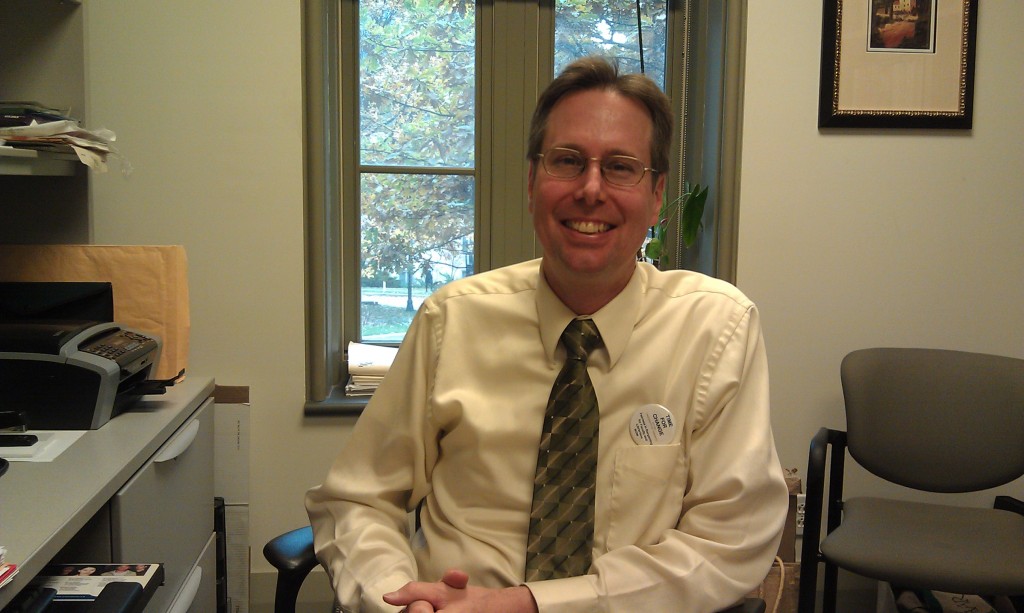Service Learning in the Humanities
Reid Locklin, Christianity and Culture Programme and Centre for the Study of Religion
At first glance, teaching a Torontonian how to play hockey might not seem to be a form of inter-religious dialogue. It’s this kind of unexpected connection, however, that gives students in Reid Locklin’s service learning courses a personal reference for the complex conflicting perspectives their discipline presents.
The idea for introducing service learning into his teaching came when Locklin, Associate Professor in the Christianity and Culture Programme and the Centre for the Study of Religion, was thinking about how best to teach the diverse student audience his courses attract. The Christianity and Culture Programme examines multiple religious perspectives from the point of view of an insider to the Christian tradition, but teaches students from Christian, post-Christian, and non-Christian backgrounds. Building on previous experiences of his own, Locklin decided to try to design “a course where the question of critical reflection on experience was introduced at the front and developed throughout the course.” Working with the UofT Centre for Community Partnerships helped him develop the courses and understand what challenges to expect. To create room for deep reflection, he builds his courses to be heavier on content in the beginning, and then eases as students move into their placements.
Locklin feels the service placements are important because they provide personal frames of reference for settings of religious difference, which are crucial for students to respond to within their field. “When you look at a theory of dialogue or theory of religious others,” Locklin says, “it matters a lot if you have someone in mind.” Service placements in Locklin’s courses range from offices like the UofT Multi-Faith Centre, Muslim, Buddhist and Hindu communities, or Baycrest hospital, which houses many Holocaust survivors.
The personal context for the reflection leads Locklin’s students to think more critically and ask more sophisticated questions. He has found that his 2nd- and 3rd-year service course often out-performs his 4th year seminar course, because of the influence of the placements. Final assignments also regularly surprise him. The first time Locklin asked students to compose a portfolio, instead of an essay, he wasn’t sure what would result. When it all added up, he found they were “some of the most amazing pieces of work [he] had ever seen.” Many students leave his courses with new clarity about possible professions, thinking about how they would like to be teachers, or deciding to pursue law.
A large part of Locklin’s role is to work with the service partners, which can lead to unexpected challenges and fruitful connections. He cites a particular example of working with an ethnically and religiously diverse Toronto neighbourhood with significant communities of Muslims and Christians. Many Muslim residents of the neighbourhood had concerns around access to hockey, and learning to skate, and so one of his students began teaching residents how to skate. It was a simple task that created a community link, and Locklin reports, “I don’t think she realized how much of a difference this was.” Rather than learning only from a textbook, his students about the complexity of self-identification within religious groups, and misrepresentations of Muslims within the community “from talking to people.”
Locklin describes the main challenge of service learning as a process of delayed gratification. “It’s busy and you don’t always see the benefits until the end.” More positively, it has also forced him, albeit “in a radical way” to understand how he uses his lectures. Since students spend so much time learning outside the classroom, he focuses his attention on how to respond to students by modelling what he wants to see in reflections. “I can be very strategic,” he says, “about using the time we do have to find something that would be helpful, instead of covering the material. I don’t have to think about just covering the material.” It pays off in the feedback from students, who tell him how helpful they find it for him to model the kind of thinking he asks them to show in reflections. It has also led him to further reflections about his field, and forthcoming publications about his teaching.
When asked about advice for other faculty thinking about introducing service learning, Locklin suggests careful thinking about how students analyze their service, and reinforces again the importance of modelling ways to reflect. He also recommends starting small, in order to learn more about how it might work, but knows there’s often no other way than large scale. “I had a teacher in composition once who told me there are things you never, ever do… unless they work! So start with a limited project unless the only real way to make service learning work in your course is to make it central.” His final piece of advice? Not to worry about things going awry. The challenges are central to learning, and often the most rewarding part of the process. “No matter what you do it’ll be messy! So go for it.”
